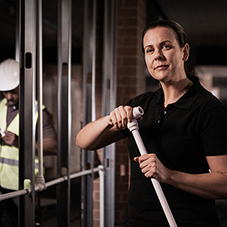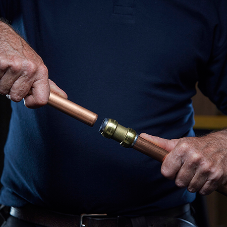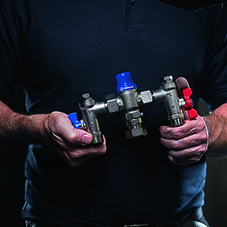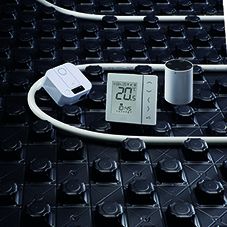Richard Bateman, Product Marketing Manager at RWC discusses how underfloor heating systems are improving sustainability in home heating.
The popularity of underfloor heating (UFH) systems has grown significantly in recent years, particularly in domestic settings spanning both new builds and renovations. While the trend towards more sustainable home heating has been driven by government ambitions to reduce emissions from the UK’s housing stock, UFH has secured its position as a viable option for homeowners. From ease of installation and cost-saving benefits through to greater comfort and enhanced efficiency, UFH is leading the way in the future of home heating.
Operating at a considerably lower temperature than traditional systems such as radiators, UFH can deliver consistent warmth more efficiently and sustainably. Whereas a radiator typically requires an operating temperature of 65-70°C to heat a space effectively, the optimal temperature of a UFH system is between 35°C and 45°C, placing significantly less demand on their heat sources . With this year’s changes to Part L of the Building Regulations stating that a new build property must have a maximum flow temperature of 55°C, UFH offers a much simpler route to compliance.
Alongside the benefits of underfloor heating itself, it can also be paired with various heat sources, giving homeowners greater flexibility when it comes to maximising efficiency. As well as being a perfect fit with both ground and air source heat pumps thanks to its lower operating temperature, UFH can also be connected to existing boilers. While heat pumps can operate up to three times more efficiently than gas boilers, both options will result in greater efficiency for homeowners moving away from traditional central heating systems in favour of UFH.
Retrofitting sustainability
While underfloor heating is easier to install in new build properties where plumbing systems are being created for the first time, its benefits can also be leveraged on retrofit projects – without the need to rip up the floor.
Designed to keep floor height to a minimum while maintaining good heat output, JG LowFit from JG Underfloor offers low-profile UFH panelling solutions for both timber and screed floor applications, ranging from 16 to 20mm in thickness.
Suitable for 12mm pipe, JG LowFit’s foil and mesh panels are typically installed upstairs over timber floors, whereas castellated panels tend to be used on ground-floor screed applications, accommodating either 12 or 15mm pipe. Timber floor solutions offer virtually no height build up, whereas screed solutions can vary between 21 to 25mm depending on the thickness of the screed and final floor covering, which is roughly the diameter of a £1 coin.
In addition to providing a low-height system that delivers discreet domestic heating, JG LowFit also supports multiple pipe layouts, including serpentine and counterflow. Alternative pipe layouts will inform the efficiency of individual systems and is something an experienced installer can recommend for the customers’ specific needs and room layouts.
Staying in control of sustainability
One of the key advantages of UFH systems that further highlights their energy efficiency lies in the ability to integrate smart controls. The inclusion of smart control technologies, such as advanced thermostats, plays a pivotal role in modern homes, allowing residents to maintain comfortable temperatures effortlessly and effectively.
These controls offer the ability to programme desired temperatures in specific rooms at designated times throughout the day. With the convenience of smartphone apps or direct thermostat control, users can actively manage their heating to reduce energy consumption and operating costs, without compromising on comfort.
Turning the whole floor space into a room’s heat source, occupants will notice more consistent warmth within a space. This is in contrast to radiators, which – as well as being more difficult to control – can leave some areas of a room feeling cold and draughty, while others are much warmer.
UFH and sustainability
Despite being hidden beneath the floor, UFH unlocks a host of benefits that make households more sustainable, comfortable and even cheaper to run.
Due to its ability to benefit homes from an energy efficiency perspective, UFH will continue to play a primary role in the future of home heating. Its versatility in new build and retrofit projects is already enabling homeowners to realise energy savings and improve sustainability. Additionally, these systems will support the UK to achieve the ambitions of the Future Homes Standard which concern the decarbonisation of the country’s current and future housing stock.
To find out more about RWC’s JG Underfloor systems, visit jgunderfloor.com
Underfloor heating and the sustainability factor
| T | (01895) 425333 |
|---|---|
| E | Info@RWC.com |
| W | Visit RWC – Reliance Worldwide Corporation's website |
| Horton Road, West Drayton, Middlesex, UB7 8JL |
Categories
Central heating systems Underfloor heating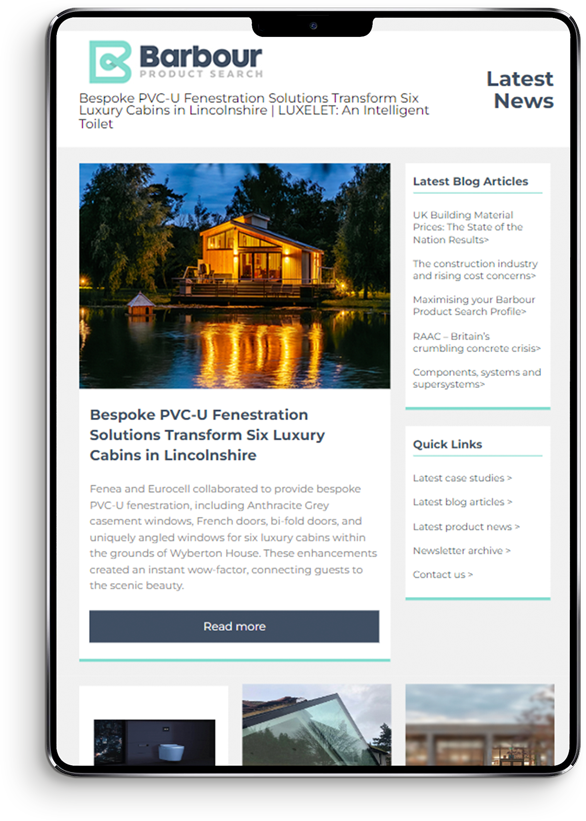

 (002)-comp104848.png)
